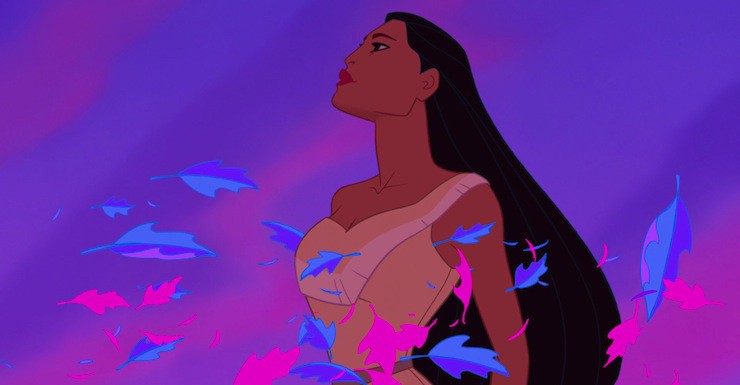Jeffrey Katzenberg, head of Walt Disney Studios in the early 1990s, could never quite manage to forget that the 1991 Beauty and the Beast had almost—almost—won an Academy Award for Best Picture, losing out to a film about a cannibal. A cannibal. On the bright side, Katzenberg figured that the nomination meant that finally, Oscar voters were ready to recognize a Disney animated film as the Best Picture of the Year. If, that is, it was serious enough. Meaningful enough. Full of the sort of Oscar bait that had earned Gandhi, The Last Emperor, and Dances With Wolves the Academy Award for Best Picture. Katzenberg considered the studio’s available options. It was far too late to transform Aladdin into that sort of serious film, and clearly, that little lion movie wasn’t going to be much more than cute animals. On a more promising note, a few animators were talking about developing a work by, all of people, that cheerful French novelist Victor Hugo, especially after the success of the musical version of his Les Miserables. But developing that work would clearly take some time.
No, the best bet, Katzenberg decided, was Pocahontas—a film that its early developers had pitched as a sorta blend between American legend and Romeo and Juliet. With a few tweaks, he figured, Disney could transform the film into a serious, sweeping, romantic contender that was perfect Oscar bait.
Unfortunately for Katzenberg, this film still had to be a Disney animated feature.
The problems just got worse from there.
As a result, Pocahontas became an uneasy mix of two films, a Big Prestige Feature and a cartoon. The first is a remarkably bland and historically inaccurate romance between sexy John Smith and the lovely Pocahontas, who isn’t particularly excited about marriage, but is excited about talking to trees and singing about the colors of the wind. The second is a funny cartoon about a raccoon, a dog, and an angry bird. It is, as said, an uneasy mix, and it doesn’t help that the second is about one hundred times better, and more suspenseful (CAN a spoiled little dog and a mischievous little raccoon become friends? CAN THEY? STOP WASTING TIME ON POCAHONTAS AND TELL ME!), with richer character development and a more realistic, adult relationship.
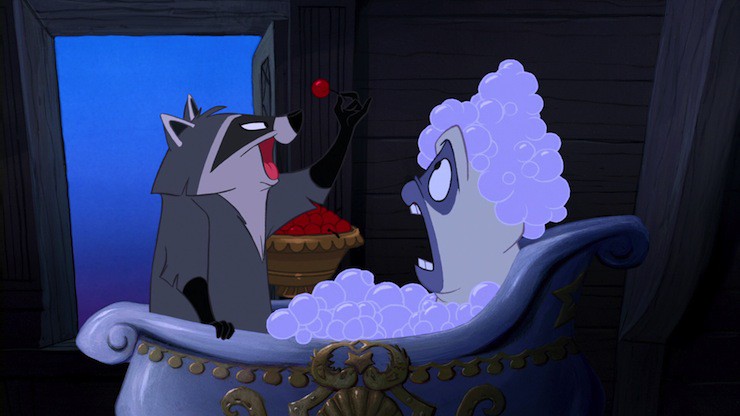
Yes, that’s right, I just compared the raccoon and the dog favorably to Pocahontas and John Smith. MEEKO AND PERCY 4EVER EVERYONE. That’s the film worth seeing.
Unfortunately, Disney wants you to pay attention to the first one, the serious work of art, and spends more of the film’s time on that one. It starts out well, with the Disney castle logo (awwwww), a glimpse of old London (oooooh, research!), and in the first ten seconds, a chorus singing out, “IN 1607, WE SAILED THE OPEN SEA! FOR GLORY GOD AND GOLD, AND THE VIRGINIA COMPANY!”
….the ship actually left in 1606.
Just ten seconds into the film, everyone. Ten seconds.
To be fair, the famous meeting between John Smith and Pocahontas took place in 1607, and Disney had valid reasons for compressing the timeline, since using the actual timeline would have forced the film to include the first, very bad winter in Jamestown which left several colonists dead not from exciting encounters worthy of animation, but from starvation and disease, something Disney wanted to gloss over to remain family friendly. To be less fair, this was but the first of a number of glaring historical inaccuracies in the film.
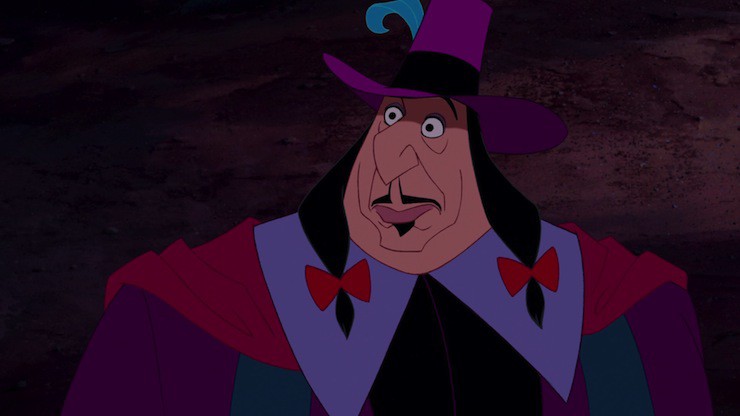
It was not that Disney made no attempts to introduce some sort of historical accuracy to Pocahontas. Disney sent the filmmakers on a nice research trip to Jamestown, brought Shirley “Little Dove” Custalow-McGowan, a teacher and descendant of the Algonquin tribes that Pocahontas was a member of, into the animation studios as a consultant, and, they claimed, consulted with other historians from the Virginia area and Native Americans.
But most of this did not make it into the film, largely because the historical reality of the Pocahontas story—filled with kidnapping, violence, starvation and death—proved difficult to shape into what Disney and Katzenberg wanted: a feel-good, sweeping historical romance with a nice environmental message. As director Mike Gabriel pointed out, the historical material, for the most part, was far too violent and depressing for a kid’s cartoon. (As he said this, other Disney animators were happily working away on a story beloved worldwide for its cheerfulness: The Hunchback of Notre Dame.) The romance was another problem: the historical Pocahontas was probably about twelve years old when she met the considerably older John Smith, and she eventually married John Rolfe, not John Smith. Smith himself was not exactly the prototype of a clean cut Disney hero. And the historical records contain very little commentary about environmental issues; certainly, the colonists and Native Americans clashed over resources, but the surviving documents do not frame these clashes in terms of environmental concerns, but rather who should have the resources in the first place.
So Disney made changes, many of them. In an incomplete list, Pocahontas was aged up, John Smith aged down, and John Rolfe entirely ignored, with Pocahontas and John Smith falling almost instantly in love. John Smith’s previous background of piracy, mutiny, and killing was glossed over or ignored. The violent clashes between colonists and Native Americans, while still present in the film, were greatly condensed, and the death count lowered from hundreds to just one. Instead of just saving the life of John Smith, and later getting kidnapped, Pocahontas convinces both groups to stop fighting and become friends. Instead of getting burned at the stake by infuriated Native Americans, as European documents attest, Governor Radcliffe is arrested for inciting violence and racism and sent him back to England. (Disney defended the last change by pointing out that in some accounts Smith was arrested by the Virginia Company for inciting violence and racism, and sent back to England, so this, at least, had some historical accuracy to it.)
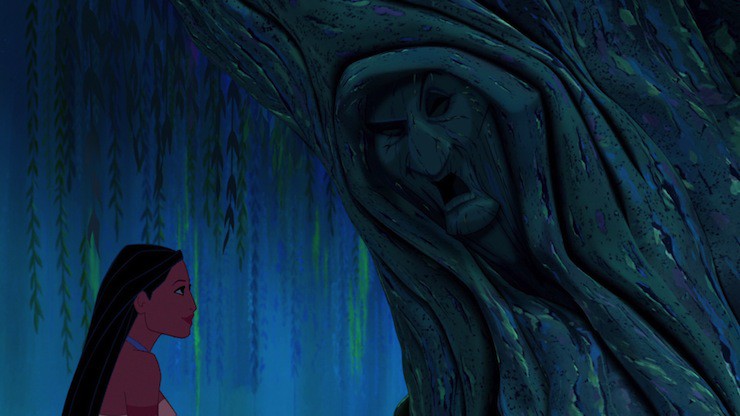
Also, Pocahontas gained the ability to talk to a tree.
Which brings up another issue: language. In his writings, the historical Smith was rarely clear about what language he used to speak with Algonquin language speakers. He did, however, spend at least one year in the Jamestown colony before setting off on his expedition, which also gave him a solid year to learn a few language basics from Powhatan visitors. The Powhatan people in turn had a solid year to learn English. Both groups may also have known some Spanish. Even after this year, however, European documents continue to record linguistic barriers, hardly surprising between two frequently hostile groups speaking very different languages.
Pocahontas takes place over a considerably shorter time period, with the entire plot taking place over at most a few months. That realistically was not enough time for either Smith or Pocahontas to gain complete fluency in each other’s languages, even if the filmmakers had been interested in showing intense language study (which they were not), but the film required the two to communicate fluently. Animators solved this plot problem through literal magic: a wind comes along (meant, as it turns out, to represent Pocahontas’ mother, something only hinted at in the film) and MAGIC! Pocahontas and John Smith understand each other, mostly, except when the film needs to make a particularly heavy handed point, and then they don’t.
This is mostly illustrated in a painful scene where John Smith mentions gold, and Pocahontas doesn’t know what gold is, which allows the film to make a HA HA HA so funny joke when Pocahontas thinks yellow corn is the “gold” Smith is talking about like HA HA HA HA ok seriously WHERE IS THE CUTE RACCOON? BRING BACK THE RACCOON! Even worse, just a few seconds after this, Pocahontas is perfectly able to understand the word “savage,” like, ok, then why don’t you know the word “gold,” and also why are you still talking to this guy and WHERE IS THE RACCOON? BRING BACK THE RACCOON! RACCOON!
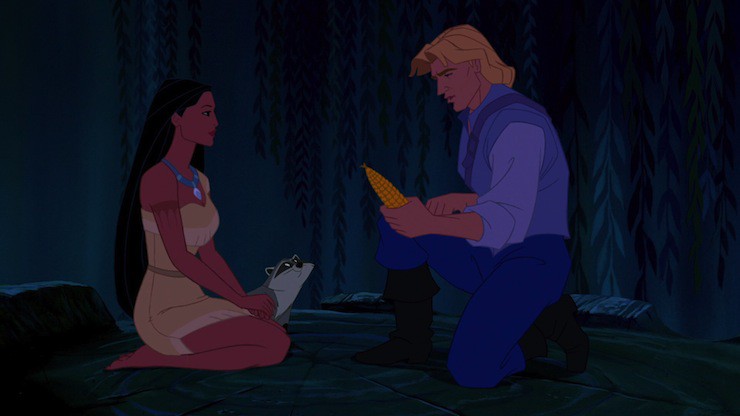
Since I’ve brought up that scene, I should note that it leads directly into the film’s signature song, “Colors of the Wind,” which whatever else can or can’t be said about it (a lot, but this post has to end at some point) accuses John Smith of various things (visiting lots of countries, thinking he owns whatever land he lands on and that the earth is just a dead thing he can claim) which are not things Pocahontas has any reason to know about at this point in the film. That at least two of these accusations are better aimed at Radcliffe than at Smith really doesn’t help, but this is a clear, and in this particular period of Disney history, rare, example of a song that not only doesn’t really advance the plot, but contradicts parts of it.
As it turns out, this is in part because “Colors of the Wind” was inspired not by anything in the life of Pocahontas or John Smith, but by the English translation of a speech by Duwamish Chief Seattle reportedly given on March 11, 1854. Chief Seattle’s speech was couched in 250 years of history; Pocahontas’s song in a couple of meetings with John Smith.
At least it has some nice stuff about preserving the environment and sycamore trees and blue corn moons, and sure, it has some of the loveliest animation in the film. But compared to the signature songs of The Little Mermaid, Beauty and the Beast, Aladdin and The Lion King, it’s a bit of a letdown.
Indeed, all of the music seems to be rather a letdown from the previous films. None of it is bad, exactly, but composer Alan Menken, who had worked so successfully with Howard Ashman, and a little less successfully with Tim Rice, reportedly found himself clashing with lyricist Stephen Schwartz. Like Howard Ashman before him, Schwartz ended up working very closely with the writers and the storyboards, more than once slightly altering the plot of the film to focus more on the idea of forming friendships between different ethnic groups—the theme he believed Disney wanted him to focus on. However well-intentioned, none of the resulting songs ended up as memorable as the songs created by Ashman and Menken, or Sir Elton John and Tim Rice.
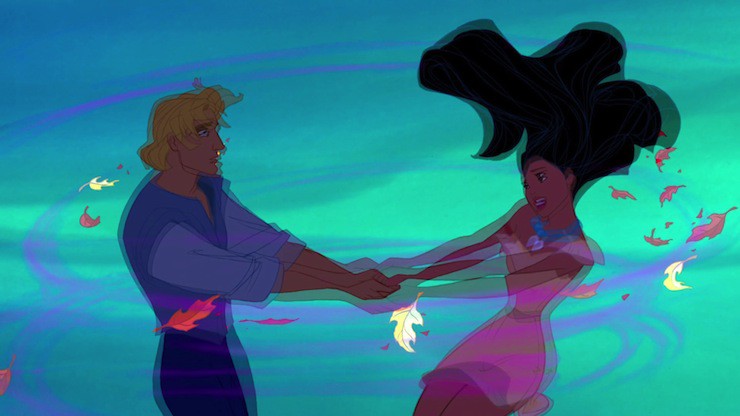
The filmmakers also faced the problem that although Pocahontas’ life is relatively well documented for a 17th century woman, the documents are all about her, not from her, or from her perspective. In a way, we know more about what Cinderella, Beauty, the little mermaid, and other inspirations for Disney animated films were thinking, since many of their tales are at least told from their perspective. The documents about Pocahontas are all told from the perspectives of others, and although they are not particularly hostile—both John Smith and John Rolfe went out of their way to put her into a good light—they tell us nothing about what she thought about what happened to her, including her capture, imprisonment, conversion to Christianity, and marriage.
I compare Pocahontas to Disney’s fairy tale princesses not to add further insult to injury here, but because Pocahontas rather strongly resembles all of her recent predecessors: like Ariel, she has adorable animal sidekicks; like Jasmine, her father wants her to marry, noting that it’s her duty; like Jasmine again, she doesn’t want to marry; like Jasmine and Belle, she’s not impressed with her prospective partner; like Jasmine and Ariel, she disobeys a beloved father; like Jasmine, Ariel, and Belle she is searching for her place in life. Also, like all of them, she doesn’t have a mother; this was not something Disney films would offer a Disney princess until Mulan.
This is all fine for a Disney film, but it does force a film that later tries to grapple with serious historical issues of colonialism and racism to start out as a Disney fairy tale. It might have been better had Pocahontas, like the later Anastasia, decided to toss history out entirely and just focus on the fairy tale, but although Pocahontas does toss out most of the history (softening John Smith in particular, and greatly reducing even the most positive depiction of the death count), it still wants to be a serious, Oscar bait film, creating an often jarring dissonance.
Especially with its ending, where—spoiler!—yes, Pocahontas and John Smith, in an unusual deference to history, do split up, but where the colonists and Native Americans agree to all just get along, something rather at odds with even the most optimistic accounts later published by John Smith.
So having said all this, is it all bad? Well, no.
The decision to make Pocahontas the important prestige picture did have the advantage of attracting Disney’s top animators to the film, as the second rated animators (much though I hate putting Andreas Deja into this category) headed off to work on little lions. Some animators—notably Ruben Aquino, at the time probably best known for his work on Ursula in The Little Mermaid—did end up working on both films, or helping with specific scenes under a supervising animator, but the majority focused on just one picture.
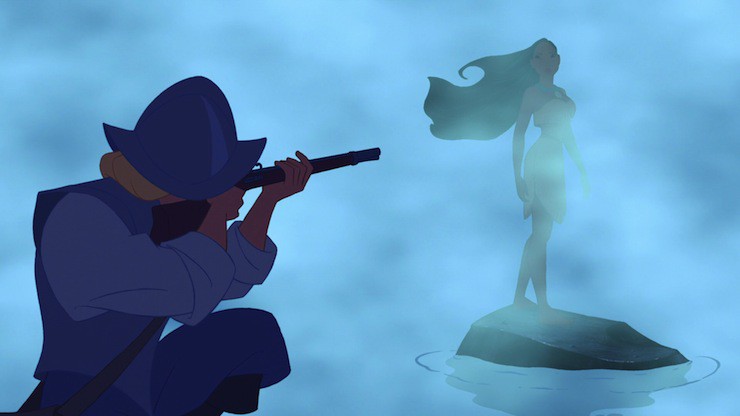
As a result, some of the animation in Pocahontas is breathtaking indeed, with the first meeting between Pocahontas and John Smith a particular highlight. I’m not sure that any of it matches up to the opening sequence of The Lion King, and it lacks the technical wonder of The Little Mermaid’s underwater world, the stately march through the seasons of Beauty and the Beast, and the sheer creative exuberance of Aladdin’s most cartoonish moments, but it can be lovely to look at.
And to ensure that you can see that loveliness, general note: Pocahontas is currently available on both Netflix and Amazon streaming, and I am going to beg you right now that if you do decide to watch this film after this post, that you find the DVD or Blu-Ray and watch that instead, because the digital transfer of Pocahontas is awful, and by awful, I mean that it is missing frames, making some of the animation look jumpy. We have plenty to criticize Pocahontas for without adding that.
I also have to applaud a film that ends with the Disney princess deciding to choose her own destiny, and waving goodbye to the guy, and a Disney animated film with—gasp—female friendships, something rare indeed in previous Disney films, Sleeping Beauty aside. Pocahontas has both Grandmother Willow (a talking tree) and, for a human friend, Nakoma. True, Nakoma ends up mostly functioning as the voice of caution and doom throughout this film, but at least she’s there—and she steps forward to help Pocahontas when needed.
Plus, of course, the raccoon, who easily could have carried this film on his own (and probably should have.) And, although somehow I managed to get this far without mentioning him, I’m also rather fond of Wiggins, Radcliffe’s personal servant, who spends the film telling hard uncomfortable truths in dulcet tones, taking care of the dog, and refining his skills with topiaries even in the midst of violence and danger. I appreciate that sort of dedication to art.
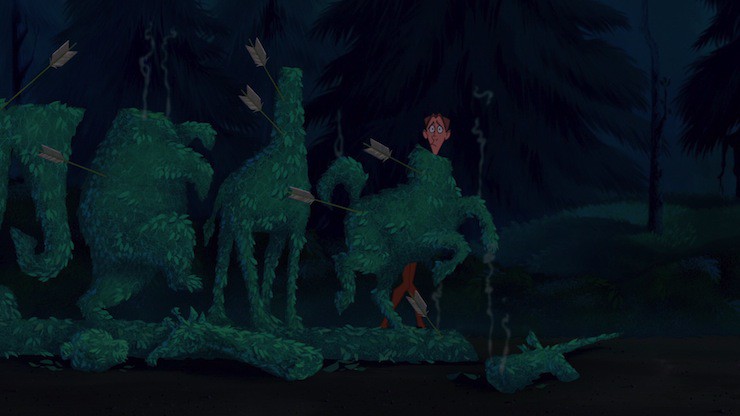
Not everyone was appreciative. Historians, Native American groups, and descendants of John Radcliffe all raised objections. Historians pointed out the multiple historical errors; Native American groups were incensed with the way Pocahontas softened the violent conflicts between Native Americans and the Jamestown colonists. Custalow-McGowan, one of the historical consultants, voiced bitter disappointment, telling People magazine, “I wish they would take the name of Pocahontas off that movie.”
Pocahontas received mixed reactions from critics. The muted response was perhaps why, to Disney CEO Michael Eisner’s disappointment, Pocahontas did only decently at the box office, bringing in about $346.1 million, making it the first Disney animated film since The Rescuers Down Under to perform worse than its predecessor at the box office—and before that, The Black Cauldron. It was a bad omen, though not enough of a bad omen to prevent Disney from making a direct-to-video sequel, Pocahontas: Journey to the New World, which I have never been able to bring myself to watch. (Apparently, Pocahontas gets caught in a love triangle between her historical husband, John Rolfe, and John Smith, and also, not enough Meeko, but that’s all hearsay, not personal experience.) Pocahontas also inspired a little YAY ENVIRONMENT show at Disney’s Animal Kingdom, and the character made several appearances at the various theme parks. Merchandise from the film got another slight boost when Pocahontas was added to the Disney Princess franchise, despite, unlike the other original Disney Princesses, ending her film waving goodbye to the guy.
But for all of Katzenberg’s hopes, although Pocahontas took home two Oscars for Best Original Song and Best Score, the film did not, as Katzenberg had hoped, blow the Academy Awards away. It was not even nominated for Best Picture.
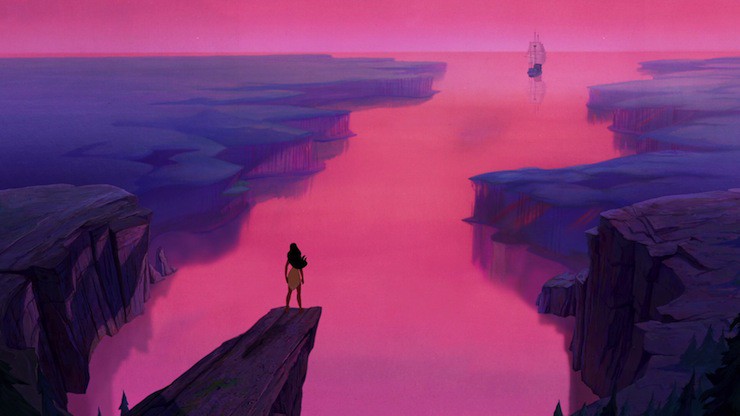
By then, Katzenberg may have felt a touch of glee at the failure: towards the end of production, Katzenberg had stormed off from Disney after a major fight with Michael Eisner, teaming up with Steven Spielberg to form rival studio Dreamworks Animation. But his desire for that Oscar still haunted the studio, as animators continued to focus on another Serious, Significant Film. They’d let that little animation company that helped develop the CAPS animation process for Disney a few years back focus on childish things, like, say, toys, and their stories. They had Victor Hugo to think of.
Next up: Notre-Dame de Paris.
Mari Ness lives in central Florida.










